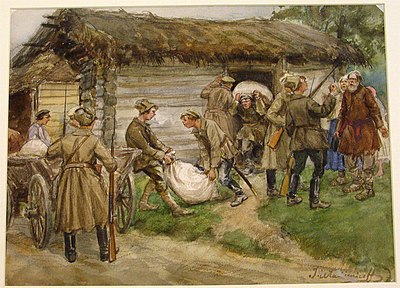
Back برودرافيورستكا Arabic Προντραζβιόρστκα Greek Prodrazviorstka Spanish Prodrazviorstka French Продразвёрстка Kirghiz Prodrazvjorstka Dutch Продразвёрстка Russian Продрозверстка Ukrainian 余粮收集制 Chinese

Prodrazverstka, also transliterated prodrazvyorstka (Russian: продразвёрстка, IPA: [prədrɐˈzvʲɵrstkə], short for продовольственная развёрстка, lit. 'food apportionment'), alternatively referred to in English as grain requisitioning,[1][2][3][4][5] was a policy and campaign of confiscation of grain and other agricultural products from peasants at nominal fixed prices according to specified quotas (the noun razverstka, Russian: развёрстка, and the verb razverstat, refer to the partition of the requested total amount as obligations from the suppliers). This strategy often led to the deaths of many country-dwelling people, such as its involvement with the Holodomor[citation needed] and Kazakh famines of 1919–1922 and 1930–1933.[citation needed]
The term is commonly associated with war communism during the Russian Civil War when it was introduced by the Bolshevik government. However, Bolsheviks borrowed the idea from the grain razverstka introduced in the Russian Empire in 1916 during World War I.
- ^ Peeling, Siobhan (2014). "War Communism | International Encyclopedia of the First World War (WW1)". encyclopedia.1914-1918-online.net. Freie Universität Berlin, Berlin, Germany. Retrieved 26 March 2023.
Practices of forcible grain requisitioning and monopolisation of supply distribution were intended to ensure minimum levels of food reached the Red Army and the starving cities.
- ^ Llewelyn, Jennifer; et al. (4 December 2012). "The New Economic Policy (NEP)". Russian Revolution. Retrieved 26 March 2023.
The NEP ended the policy of grain requisitioning and introduced elements of capitalism and free trade into the Soviet economy." "The formal decree that introduced the NEP was called "On the replacement of prodrazvyorstka [grain requisitioning] with prodnalog [a fixed tax]". Under war communism and prodrazvyorstka, the amount of grain requisitioned was decided on-the-spot by unit commanders.
- ^ "Prodrazverstka | Encyclopedia.com". www.encyclopedia.com. Retrieved 27 March 2023.
- ^ "Instructions for Requisitioning Grain". Seventeen Moments in Soviet History. 24 August 2015. Retrieved 27 March 2023.
- ^ alphahis (26 July 2019). "Bolshevik decree on food procurement (1918)". Russian Revolution. Retrieved 27 March 2023.